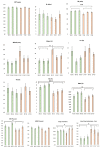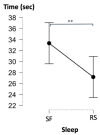Impact of Sleep Fragmentation on Cognition and Fatigue
- PMID: 36497559
- PMCID: PMC9740245
- DOI: 10.3390/ijerph192315485
Impact of Sleep Fragmentation on Cognition and Fatigue
Abstract
Sleep continuity and efficacy are essential for optimal cognitive functions. How sleep fragmentation (SF) impairs cognitive functioning, and especially cognitive fatigue (CF), remains elusive. We investigated the impact of induced SF on CF through the TloadDback task, measuring interindividual variability in working memory capacity. Sixteen participants underwent an adaptation polysomnography night and three consecutive nights, once in a SF condition induced by non-awakening auditory stimulations, once under restorative sleep (RS) condition, counterbalanced within-subject. In both conditions, participants were administered memory, vigilance, inhibition and verbal fluency testing, and for CF the TloadDback, as well as sleep questionnaires and fatigue and sleepiness visual analog scales were administered. Subjective fatigue increased and sleep architecture was altered after SF (reduced sleep efficiency, percentage of N3 and REM, number of NREM and REM phases) despite similar total sleep time. At the behavioral level, only inhibition deteriorated after SF, and CF similarly evolved in RS and SF conditions. In line with prior research, we show that SF disrupts sleep architecture and exerts a deleterious impact on subjective fatigue and inhibition. However, young healthy participants appear able to compensate for CF induced by three consecutive SF nights. Further studies should investigate SF effects in extended and/or pathological disruption settings.
Keywords: cognitive fatigue; cognitive functions; sleep fragmentation.
Conflict of interest statement
The authors declare no conflict of interest. The funders had no role in the design of the study; in the collection, analyses, or interpretation of data; in the writing of the manuscript, or in the decision to publish the results.
Figures









References
-
- Jiang Y., Chai Y., Yang F., Xu S., Basner M., Detre J.A., Dinges D.F., Rao H. Effects of Sleep Deprivation and Recovery Sleep on Human Brain Network Organization. Sleep. 2018;41((Suppl. S1)):A85–A86. doi: 10.1093/sleep/zsy061.217. - DOI
-
- Laharnar N., Fatek J., Zemann M., Glos M., Lederer K., Suvorov A.V., Demin A.V., Penzel T., Fietze I. A sleep intervention study comparing effects of sleep restriction and fragmentation on sleep and vigilance and the need for recovery. Physiol. Behav. 2020;215:112794. doi: 10.1016/j.physbeh.2019.112794. - DOI - PubMed
Publication types
MeSH terms
LinkOut - more resources
Full Text Sources

